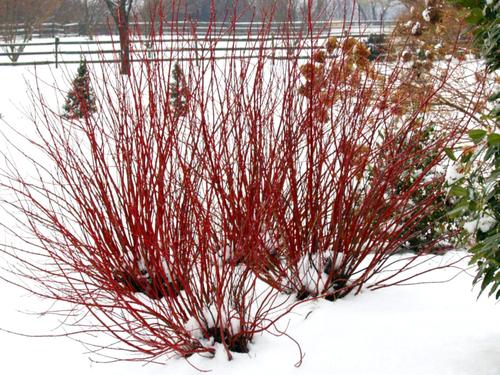Winter officially begins on December 21st. Ugh, now I am depressed!. Gray, dull, and dark are the words that often come to mind when describing the winter landscape we live in here in the Midwest. Well at least after the holidays are over and the Christmas lights are all taken down (except for that one neighbor that leaves them up till Labor day (you know who you are!).

Well, it is possible to have color in your landscape in the winter if you include the right plants. In a previous post, I talked about two of my favorite small trees for winter bark. Today, I’d like to add a couple of plants with red winter stem color that really add to the winter landscape especially when offset by fresh white snow.
WONDERFUL RED
Why red? Well, red is opposite on the color wheel from green, which means it complements green well. Think Christmas here. Red also stands out when surrounded by white snow very well.
Try putting the shrubs in front of where there is grass or another easily snow covered ground cover and they will standout better.

Put the tree close to the house so the sky is its background when it grows to its mature size. Try not to have too much stuff going on behind them in the background from your primary winter view or you won’t see them as easily.
TREE WITH RED WINTER STEM COLOR
CORAL BARK JAPANESE MAPLE (Acer palmatum ‘Sangokaku’)
The coral bark Japanese maple is a standout in the winter mainly for its bark color. The previous year’s growth is a bright red color in the winter. So the effect is that the branch tips are a bright red while the older stems are duller. As with all colored stem, the closer the plant is to the house the brighter its color will appear.

These are also a nice Japanese maple for the rest of the year as they are one of the few commonly available NON purple varieties. Green is a really nice color for a leaf. It really is (say’s the man with two purple leafed beeches and three purple leafed Japanese maples). It is a Japanese maple so of course it also has a nice fall color. The fall color is usually a nice orange.
[slideshow id=6]
It should go without saying, but I’ll say it anyways, prune this in late winter or in the spring. You don’t want to cut off the colorful part of the stem with summer or fall pruning. The Coral Bark Japanese Maple is hardy in zone 5-8 and growths to 15 to 20 feet tall and wide.
SHRUB WITH RED WINTER STEM COLOR
Now my pick for a great red stemmed shrub is, drum roll………………………………………
Red twig dogwood. Thud.
Sorry, it’s not too exciting a pick, but it CAN be a very nice plant to add to the garden. That is if you pick the right one. Redtwig dogwoods are really two different species, Tatarian Dogwood (Cornus alba) and Redosier Dogwood (Cornus sericea.)
Both of these can often get big open and kind of nasty if you pick the wrong one and don’t prune it regularly. They also can get leaf spot and twig blight. If you pick compact growing ones and put them in a nice spot with full sun to part shade, they will be nice additions to your winter landscape that don’t need a lot of care.
The two I would suggest are Arctic Fire® Red Twig Dogwood or Ivory Halo® Dogwood.

Artic fire gets about 3 to 4 feet high and wide and has normal green leaves. It is a “Proven Winners” selection that is often available.

Ivory Halo grows a bit larger to 5 to 6 feet tall and wide has a white variegated leaf margin. I have had this plant in my yard for a couple of years now and have found it to be a nice slow growing compact variety. The variegated leaf makes it standout nicely in the summer too.
There are yellow stemmed varieties also available, however these have proven to have more disease problems than they are usually worth.
Click of the following links for more information on Coral Bark Japanese Maple, Arctic Fire® Red Twig Dogwood or Ivory Halo® Dogwood.
Dennis says
Hello Jim.. I am a new reader and have a question about our Ivory Halo Dogwoods. One of our plants (we have five providing shade to the south wall/windows here in Iowa) has small bugs on the back of the leaves and a white milky substance at each branch juncture on new growth. What might this be and what should we do to treat it? Thank you ahead of time.
Jim says
Are the small bugs green? Aphids perhaps? If so just blast them off with a hose of water.
becca tointon says
Thanks for the great ideas. Michigan winters are dull and any splash of color would be great!